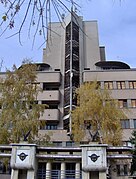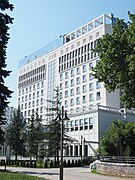Dragiša Brašovan
Dragiša Brašovan | |
|---|---|
| Born | May 25, 1887 |
| Died | October 6, 1965 (aged 78) |
| Nationality | Serbian |
| Occupation | Architect |
Dragiša Brašovan (Serbian Cyrillic: Драгиша Брашован) (May 25, 1887 – October 6, 1965) was a Serbian modernist architect, one of the leading architects of the early 20th century in Yugoslavia.[1]
Works[]

Brašovan's personal items, Gallery of Matica Srpska
- Serbian, Croatian and Slovene Pavilion for the 1929 Barcelona International Exposition. Was with the Barcelona Pavilion of Mies van der Rohe and the Swedish Pavilion of the only examples of avant-garde architecture. The building, demolished after the exposition, had the shape of an irregular star and the façade had no ornamental elements as the other historicist pavilions.
- The Museum of Nikola Tesla building, 1932.
- The State Printing building (later building), 1934-1941.
- Command of the Air Force Zemun, 1939.
- Hotel Metropol, 1953.
- Several buildings built in the 1930s (Francuska no. 5, Liberation Blvd. No.2, Boulevard of Despot Stefan no. 8, etc.).
- Apartment blocks of (FX), built in the late 1950s
- Workers' Association, 1931.
- Banovina building, (now the Executive Council of Vojvodina), 1939.
- Main Post Office, 1961.
- Church of the Presentation of Mary, 1924-1927.[2]
- Serbian bank building, about 1920th
- Sokolski dom, 1927.
Gallery[]

Air Force Command in Zemun.

Banovina Palace in Novi Sad.

Serbian, Croatian and Slovene Pavilion, Barcelona 1929.
Church in Orlovat.
BIGZ building.
Nikola Tesla Museum.
Hotel Metropol in Belgrade.
See also[]
References[]
- ^ Blagojevic, Ljiljana (2003). Modernism in Serbia: The Elusive Margins of Belgrade Architecture, 1919-1941. MIT Press. Dust jacket. ISBN 978-0-262-02537-9.
- ^ 20bogoroice.htm Church of the Presentation of the Virgin in Orlovat[permanent dead link]
External links[]
| Wikimedia Commons has media related to Dragiša Brašovan. |
Categories:
- 1887 births
- 1965 deaths
- People from Vršac
- Serbian architects







